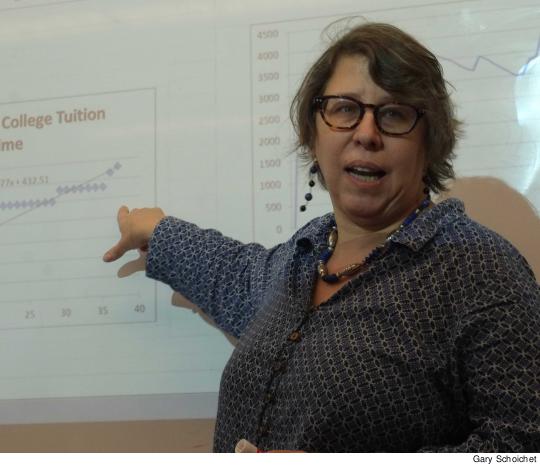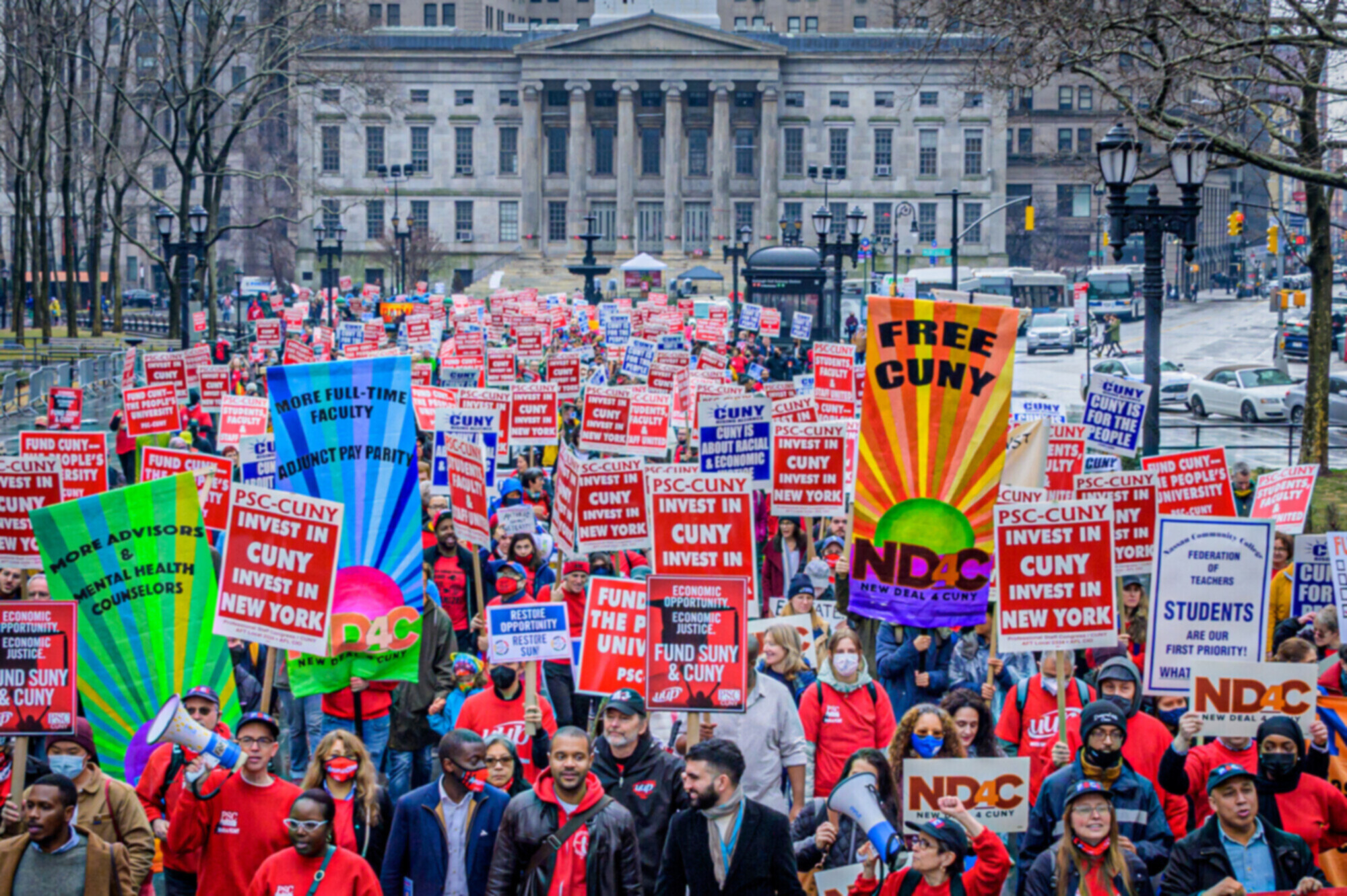In Kathleen Offenholley’s mathematics class at the Borough of Manhattan Community College (BMCC), students are getting a lesson in regression lines and equilibrium using a case study that hits close to home: the rate of decrease in state aid per full-time student compared with the increase in community college tuition over the years. “You can see that the two lines have met and that students are now paying more themselves than state aid is paying,” she explains, showing the trends on a graph.
 |
Since the 1990-91 school year, tuition and fees have more than doubled as a proportion of community college revenues, while state aid to CUNY community colleges fell from 36 to 25 percent.
CUNY in the Classroom
“It kind of pissed me off in a way,” BMCC student Alex Atkinson, who works full-time in a restaurant and pays her own tuition, told Clarion. “They’re raising tuition and they’re not offering more.”
Offenholley’s CUNY-focused lesson plan is part of “Teach CUNY,” a PSC initiative to make the University itself a subject of investigation with students. Teach CUNY was introduced in 2001, during another period of budget cuts, and was relaunched this fall as part of escalating contract and budget campaigns. Faculty across the University held teach-ins and developed curricula around the topic appropriate to their courses.
In political science classes, students learned about the legislative process by which the “maintenance-of-effort” bill (which was awaiting action by the governor as Clarion went to press) was passed by the State Assembly and Senate, and learned the language of legislation. Elsewhere, a group of first-year students were given a lesson on the history of CUNY by their counselor. Students in one English class wrote about the roles of faculty and students in seeking justice within the college community.
Teaching a sociology class at Baruch, Luke Elliott-Negri engaged students in a discussion of current political conversations about making higher education tuition-free. “When you link it to the fact that for generations working class immigrants in the city could get a bachelor’s degree free [at CUNY] and now they and their parents are paying for it, I think that makes it much more real,” said Elliott-Negri, who is a graduate employee and chairs the PSC Graduate Center chapter.
At Bronx Community College, Victor Rodriguez, acting coordinator of general counseling in the Division of Student Affairs, taught a freshman seminar on open admissions at CUNY, a policy now restricted to the community colleges but which once applied to senior colleges, as well.
“I’m a SEEK graduate myself,” Rodriguez explained, referring to the Search for Education, Elevation, and Knowledge opportunity program that admits low-income students to the senior colleges who may not have received the standard level of academic preparation for acceptance.
A Fading Opportunity
Rodriguez teaches students how the fight for open admissions was won during the Civil Rights movement in 1970, only to be lost at the senior colleges in 1999, during the administration of Mayor Rudolph Giuliani. “I’ve been connecting recent struggles around tuition hikes and contract negotiations” to the loss of the university-wide open admissions policy, said Rodriguez, who graduated from City College in 1981.
“Some students have really emotional reactions. One recently told me that he felt like crying,” Rodriguez said. “I guess it was going through the history, the struggle and having the realization that the opportunity is fading.”
Chet Jordan teaches a research-based English composition course at Guttman Community College and has students writing on the theme, “The art of protest movements.”
“We went over some primary source materials, like [PSC President] Barbara Bowen’s letter on the strike authorization vote and the PSC-CUNY contract,” Jordan said.
His students, he said, saw the connection between the workload problems over which PSC is negotiating with CUNY management and the quality of their education.
“They got it,” he said. “My pay doesn’t really impact them that much, but the workload [does],” he said, because they consequently receive less personalized attention, Jordan said.
Back at the BMCC math class, Offenholley uses graphs to give her students a bonus lesson on the economics, of inflation and the term “real dollars.”
The case study is CUNY’s tuition and how the cost of community college now compares to the cost decades ago once consumer price index is taken into account. “A lot of the students are going to be business majors, so they are interested in what real dollars and adjusting for inflation means,” Offenholley told Clarion.
Making Connections
Offenholley also shared with students her plans to participate in the PSC’s civil disobedience action, which took place on November 4. (See “Militant action highlights contract fight.”)
“‘Why?’ they ask. I tell them, ‘Your tuition money is not supposed to go to keeping the lights on,’” says Offenholly. “‘The state is supposed to be paying money so that I can have a decent salary and so that you guys can have an increased quality of education. That’s not what’s happening.’”

